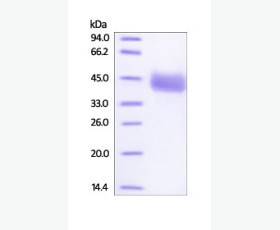Recombinant Human LIM and Cysteine-Rich Domains Protein 1/LMCD1/Dyxin
| Product name: | Recombinant Human LIM and Cysteine-Rich Domains Protein 1/LMCD1/Dyxin |
| Source: | E. coli |
| Purity: | Greater than 95% as determined by reducing SDS-PAGE. |
| Buffer Formulation: | Supplied as a 0.2 μm filtered solution of 20mM PB,150mM NaCl,pH7.4. |
| Applications: | Applications:SDS-PAGE; WB; ELISA; IP. |
| Storage: | Avoid repeated freeze/thaw cycles. Store at 2-8 oC for one month. Aliquot and store at -80 oC for 12 months. |
| UOM: | 100ug/50ug/200ug/1mg/1g |
| Source | E. coli |
| Description | Recombinant Human LMCD1 is produced by our E.coli expression system and the target gene encoding Met1-Ser365 is expressed with a 6His tag at the N-terminus, 6His tag at the C-terminus. |
| Names | LIM and cysteine-rich domains protein 1, LMCD1, Dyxin |
| Accession # | Q9NZU5 |
| Formulation | Supplied as a 0.2 μm filtered solution of 20mM PB,150mM NaCl,pH7.4. |
| Shipping |
The product is shipped on dry ice/ice packs. |
| Storage |
Store at < -20°C, stable for 6 months after receipt. Please minimize freeze-thaw cycles. |
| Purity |
Greater than 95% as determined by reducing SDS-PAGE. |
| Endotoxin | Less than 0.1 ng/µg (1 IEU/µg) as determined by LAL test. |
| Amino Acid Sequence |
MGSSHHHHHHSSGLVPRGSHMAKVAKDLNPGVKKMSLGQLQSARGVACLGCKGTCSGFEPHSWRK ICKSCKCSQEDHCLTSDLEDDRKIGRLLMDSKYSTLTARVKGGDGIRIYKRNRMIMTNPIATGKD PTFDTITYEWAPPGVTQKLGLQYMELIPKEKQPVTGTEGAFYRRRQLMHQLPIYDQDPSRCRGLL ENELKLMEEFVKQYKSEALGVGEVALPGQGGLPKEEGKQQEKPEGAETTAATTNGSLSDPSKEVE YVCELCKGAAPPDSPVVYSDRAGYNKQWHPTCFVCAKCSEPLVDLIYFWKDGAPWCGRHYCESLR PRCSGCDEIIFAEDYQRVEDLAWHRKHFVCEGCEQLLSGRAYIVTKGQLLCPTCSKSKRSLEHHH HHH
|
| Background | LMCD1 is transcriptional cofactor which contains a cysteine-rich domain in the N-terminal region and 2 LIM domains in the C-terminal region. It also has several potential phosphorylation and N-myristoylation sites and a single potential N-glycosylation site. LMCD1 is expressed in many tissues with highest abundance in skeletal muscle. LMCD1 restricts GATA6 function by inhibiting DNA-binding, resulting in repression of GATA6 transcriptional activation of downstream target genes. It plays a critical role in the development of cardiac hypertrophy via activation of calcineurin/nuclear factor of activated T-cells signaling pathway. |














